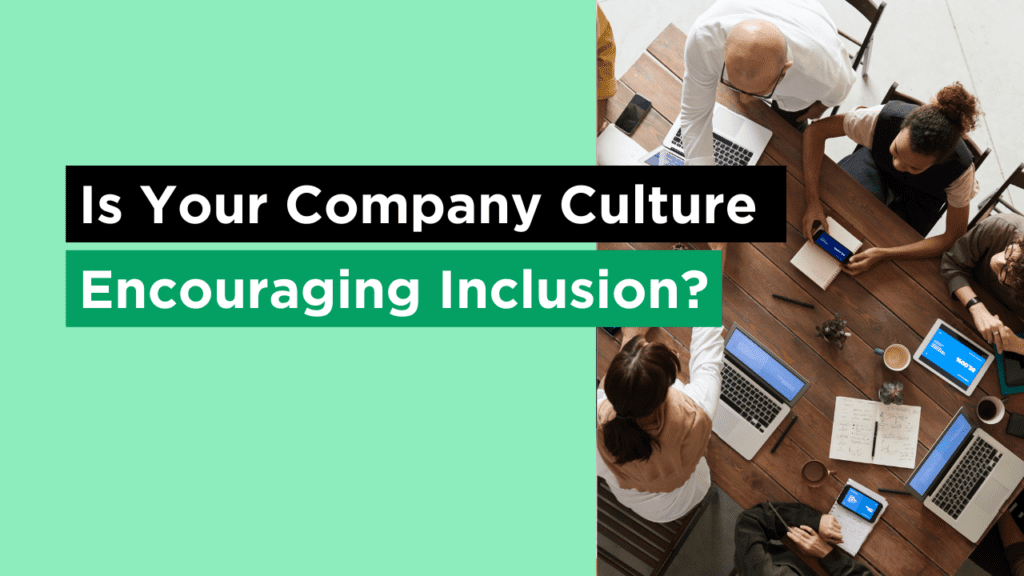Have you ever stopped to think about what makes you different? What makes your company stand out from the crowd? And why should employees join you over the wide range of competitors in your market?
Well, one key differentiator is an inclusive company culture. According to research carried out by SurveyMonkey a massive 80% of survey respondents said they want to work for a company that values DEI issues. Imagine being not only that organisation that people want to be part of, but also known as a leader who values people, puts them first, and supports both personal and professional growth?
Building high performing teams with a wide range of thoughts and experiences is within reach. And this blog will equip you with insights and strategies for promoting inclusivity in your organisation. Did you know that as a HR professional or company leader, you have the power to really take control of diversity and inclusion and create a workplace where every employee feels valued?
Let’s dive into how you can transform your business with inclusivity.
Understanding Company Culture and Inclusion
Think of your culture as the personality of your organisation. It’s made up of values, behaviours, and practices. It’s basically how you’d sum up things like how people:
- Feel
- Behave
- Communicate
- Interact
- Make decisions
- Approach their roles
A strong company culture should align with the business’ mission and goals, and everyone will understand what’s expected of them in order to meet your shared objectives.
Inclusivity at work also means developing a place where every employee, regardless of their differences, feels valued, respected, and motivated to contribute their best. Your aim as an employer is to have every individual bring their whole selves to work. Remember, inclusivity isn’t just about representation or ticking a box; it’s about a deeply ingrained culture that embraces and celebrates diverse perspectives and directly contributes to your success.
Assessing Your Current Company Culture
So, you want to create an inclusive work environment? Firstly, you need to think about where you currently are. Take some time to assess how you’re already embracing diversity. And, of course, look for any red flags that indicate you’re not quite there yet when it comes to meeting your diversity and inclusion ambitions.
Key Indicators of an Inclusive Culture
Organisations that are truly inclusive will share some of the same characteristics. They may include:
- Diverse Leadership: Leadership teams that reflect a wide variety of backgrounds and perspectives. When you have diverse leadership, you’re essentially setting a positive example for the rest of your firm.
- Open Communication Channels: This is about employees feeling comfortable with voicing their opinions and concerns. They should know they’ll be heard and respected, regardless of their experience or role.
- Fair Promotion Practices: Clear, non-biased paths to advancement will be accessible to all employees. They’ll be based on merit, rather than subjective criteria.
- Inclusive Policies and Practices: Policies will support things like work-life balance and flexible working arrangements. They’ll be adaptable enough to accommodate a variety of diverse needs and not just select groups.
Identifying Red Flags
It’s not all about indicators of inclusivity. While indicators are positive, it’s just as important to look out for potential red flags, i.e. characteristics that suggest a lack of inclusivity. These include:
- High Turnover Rates Among Minority Groups: Persistent turnover can suggest that certain groups don’t feel valued or supported.
- Cliques Within Teams: If there’s a lack of integration among team members then it can lead to exclusion. This obstructs collaboration and communication and will hinder your attempts to create an inclusive environment.
- Absence of Diverse Voices in Decision-Making: If decision-making groups are homogenous, it can stifle innovation and leave you with a lack of diverse perspectives.
- Limited Employee Engagement: When enthusiasm or participation in company initiatives are missing, this is a sure sign of underlying issues with inclusivity.
Using Data and Feedback for Evaluation
How can you gain an in-depth understanding of your company’s inclusivity? Opinions and observations alone aren’t enough. The key lies in using both quantitative and qualitative data to get a more realistic and scientific view of how inclusive you are. We suggest:
- Employee Surveys: By regularly conducting surveys to gather insights you’ll learn about employee satisfaction, engagement, and perceptions of inclusivity. By allowing employees to respond anonymously, you’re more likely to get honest and accurate feedback.
- Diversity Metrics: Make sure you’re analysing data on hiring, retention, and promotions to identify patterns and disparities. Look out for trends that suggest certain groups may be being favoured.
- Direct Feedback: It’s important to encourage open dialogues about inclusivity. It should never be a taboo subject. Instead, make it part of day-to-day conversations and support employees to share their experiences and suggestions for improvement without fear of repercussions.
Areas for Improvement in Building an Inclusive Culture
Like anything that’s worth time and effort, there’s no quick fix to creating an inclusive culture. It’s an ongoing journey that you need to commit to. And it requires effort, strategy and continuous improvement efforts which should include:
Leadership Commitment
Every inclusive culture starts at the top and cascades down. Getting buy-in and commitment from leaders is crucial – after all they’re the ones who set the tone for the entire organisation. Top management must visibly support, champion, and celebrate everything ‘diversity and inclusion.’ From actively participating in inclusion initiatives, to communicating its importance, it’s vital they lead by example. Commitment like this can inspire employees and also reinforces the fact your company’s welcoming and supportive to everyone.
Inclusive Policies and Practices
Do your company policies align with your inclusivity goals? Revisit them regularly to check. Nowadays, inclusivity means making work accessible to all, so are you offering things like flexible work arrangements that accommodate a range of diverse needs? Are you also paying fairly across all groups and in line with market averages? And do you have, communicate and promote, anti-discrimination policies? Make sure your policies are transparent and updated regularly – they need to reflect the ever-evolving needs of your workforce.
Training and Development
Education is so powerful! It can really help you to build an inclusive culture, because activities like training (for example on unconscious bias, cultural competence, or inclusive leadership) can significantly enhance people’s awareness and understanding. Again, this shouldn’t be a one-off initiative. Instead make programs ongoing and interactive so people gain an innate understanding of how to recognise and mitigate biases. Inclusivity can only happen when everyone’s on the same page.
Diverse Hiring and Promotion Practices
If you want to be truly inclusive, you must have diverse hiring and promotion practices in place. Look to create equal opportunities for all employees, always focusing on merit-based advancement and diverse recruitment strategies. And shout about how you’re committed to being a fair, inclusive, and equal opportunities employer on job ads, your website and other comms. At Solutions Driven, we continuously help our clients with these kinds of processes and we use our expertise to help companies identify how they can better attract and retain diverse talent. Get in touch if you’d like some assistance in improving your hiring and promotion practices.
How to Recognise When Your Culture is Promoting Inclusivity
How do you know when you’ve nailed it? When your company culture is genuinely promoting inclusivity? This is an important question to ask if you want to create a sustainable and successful inclusive work environment. Some key indicators that will tell you that your culture’s on the right track, include:
Positive Employee Experiences
You know you have an inclusive culture when employees feel comfortable bringing their authentic selves to work. Look out for people openly sharing their unique perspectives, and contributing their ideas freely, because it’s having this voice and a sense of belonging that shows people feel safe and respected.
Innovation and Collaboration
When you’re embracing inclusivity, you’ll also encourage greater innovation and collaboration. Diverse teams bring a range of perspectives, which means more creative solutions and better problem-solving. And in this kind of co-operative culture, teams are more likely to engage in constructive discussions, challenge the status quo, and come up with more innovative strategies. By blending diverse thoughts and experiences you’ll improve your ability to adapt and remain competitive too.
Employee Retention and Satisfaction
There’s a strong correlation between an inclusive culture and high levels of employee retention and satisfaction. Because when employees feel included and appreciated, they’re more likely to be loyal and stay with you for the long haul. Not only is this great for your productivity and reputation you’ll reap additional benefits such as saving costs associated with having to replace staff. And don’t forget increased employee satisfaction has a positive effect not only on individual and team growth but overall business success too.
To wrap up our discussion on encouraging an inclusive company culture, remember any DE&I initiative is about far more than ‘doing the right thing.’ When you instil inclusivity into the foundation of your business – and it becomes part of your everyday working life – you’ll drive business success and boost employee well-being.
Ultimately, creating an inclusive culture takes time – not to mention continuous effort and commitment from both leaders and employees. It’s about building an environment where everyone feels valued and empowered to contribute their best. You’re looking to give the individuals in your organisation a sense of belonging.
Why not set some time aside to take a closer look at your company’s inclusivity practices? Evaluate where you stand, identify areas for improvement, and plan the proactive steps you can take towards building a culture that embraces diversity and inclusion.
If you’re wondering where to start and would like some support on your journey to improving inclusivity, why not contact our experts at Solutions Driven? We’re working with organisations like yours daily, to help them attract and retain great talent that will take their business from strength to strength.





